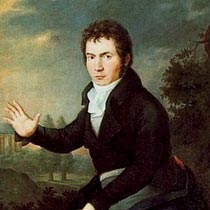Beethovens Third - The Great Eroica Symphony
Beethovens Third symphony (the Eroica symphony) was one of the most important milestones in classical music, and a triumphant piece of art.
Beethoven injected his symphony with a passion, an intensity, and ideas that had never been heard before.
The Symphony was also very long and complex for its time, and confused most first-time listeners. But they quickly saw its importance, which inspired composers for generations after.
History of the Symphony
Beethoven wrote the Eroica symphony at a crucial time in his life. He was slowly losing his hearing and falling into a deep depression. He even contemplated suicide.But it was his music that kept him going - he wanted to write the great music which he felt was inside him. He willed himself to conquer his deafness and persist in creating.
Beethoven also wanted to strike out on a "new path". So in 1803 he began sketching out what would become the Eroica, and finished it the next year. The public premiere was in August 1805.
Beethoven uses the symphony to convey his ideas about heroism and revolution, which was messing up all Europe at the time.
He was full of enthusiasm and respect for the French Revolution's ideals, and especially (at first) Corsican leader Napoleon Bonaparte. Beethoven originally dedicated the symphony to him.

He changed the name to Sinfonia Eroica (heroic symphony), and dedicated it "to the memory of a great man".
The Music of Beethovens Third
 Beethovens third is super-important in the history of classical music. It's like a bridge that connects two eras.
Beethovens third is super-important in the history of classical music. It's like a bridge that connects two eras.First, it's a an example of the height of "classical era" music. It follows the traditions of the past masters (breaking the rules a bit though!).
But it also has a strong streak of Beethoven's fiery, passionate emotions. This is a defining feature of the "romantic era", which the symphony is ushering in.
It's also a personal transition point for Beethoven. The Eroica marks the beginning of his "middle style", full of grand heroic music. The symphony, full of gushing ideals and explosive heroics, crowns this period.
The work confused listeners at first, and musicians found it long and difficult. All of its new features changed the definition of a symphony. No longer a short evening's entertainment, the genre became a serious artistic endeavor. People now had to study and ponder over it to enjoy it fully!
Here are the four movements of Beethovens Third Symphony...
- Allegro con brio (quickly, with vigor). Opening with two powerful chords, this movement depicts struggle, persistence, and eventual triumph, all in 15 (roughly) minutes of glorious music.
It's structured in traditional Sonata form (i.e. melody, playing around with melody, repeat melody, extra little coda). But Beethoven stretches each section out so much that it must have exhausted listeners when it was brand new!
The first movement is actually longer than a lot of Mozart (click for biography) or Haydn's entire symphonies.
- Adagio assai (extremely slowly). A brooding funeral march, as if for a revolutionary leader.
- Allegro vivace (quick and lively). a bouncy, light-hearted scherzo, breaking the tension from the previous two movements. It has a great horn passage in the middle.
- Allegro molto (very quick). This is Beethoven in full 'heroic' mode. A dramatic cascade of strings brings us to the simple main theme of this movement (which Beethoven actually used in two other pieces before this one). The rest of the movement is made up of variations on this main theme, and the symphony ends in a glorious blaze.
Click for more of the master composer's famous pieces...
Recordings
Since it's such an important symphony, there are hundreds of recordings of Beethovens third. My suggestions for you are my three handpicked favorite ones. I generally prefer faster tempos and a slightly rawer sounds for this symphony, since it gives it that revolutionary sound.
By far my favorite is the 1944 recording conducted by Wilhelm Furtwangler with the Vienna Philharmonic. This is a powerfully arresting performance, which although slightly slow to my ears makes up for it with raw energy.
The 2nd movement is especially gloomy, with an epic touch perhaps inspired by the dark circumstances of the recording's era.
Just listen to the opening chords... wow!
More Beethoven symphonies...
If you like my site, please click "Like"... thanks!



